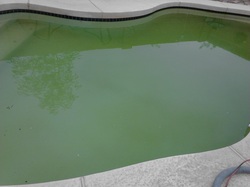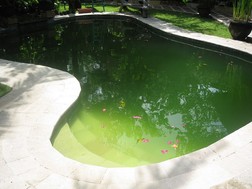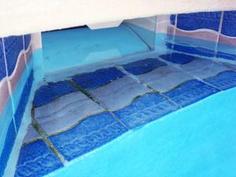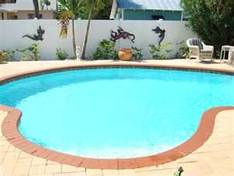Blue/Green Algae

Is several types of algae that reside in the same area and they are made of a bacteria known as Cyanobacteria that live in shallow, still and slow moving waters.
In order for blue-green algae to thrive, several factors must be met. First the temperate must be warm. This is why you don't seen algae in the dead of winter in most locations. Second, there must be adequate sunlight as the bacteria that create algae needs sunlight to grow and thrive in general.
Green algae will show up immediately following a hazy condition in the water from a lack of proper filtration and/or sanitation. It is frequently found free floating in the water, although it also will cling to the walls. It reduces water clarity which will impart a clear, green color to the water. Varieties of green algae also appear as "spots" on surfaces, particularly rough areas, or places where circulation is low. They also show up as "sheets", where large wall sections, or even the entire pool, is coated in green slime.
Q: What causes Blue/Green Algae?
A: Heat, slow moving water (lack of filtration and/or sanitation)
Solution – Customer needs to run pool more often and keep ample amounts of chlorine in pool.
In order for blue-green algae to thrive, several factors must be met. First the temperate must be warm. This is why you don't seen algae in the dead of winter in most locations. Second, there must be adequate sunlight as the bacteria that create algae needs sunlight to grow and thrive in general.
Green algae will show up immediately following a hazy condition in the water from a lack of proper filtration and/or sanitation. It is frequently found free floating in the water, although it also will cling to the walls. It reduces water clarity which will impart a clear, green color to the water. Varieties of green algae also appear as "spots" on surfaces, particularly rough areas, or places where circulation is low. They also show up as "sheets", where large wall sections, or even the entire pool, is coated in green slime.
Q: What causes Blue/Green Algae?
A: Heat, slow moving water (lack of filtration and/or sanitation)
Solution – Customer needs to run pool more often and keep ample amounts of chlorine in pool.
Yellow Algae

A wall clinging variety, also called mustard algae, attach around the walls and grow underneath the shady parts of the swimming pool. These are small, single-celled plants that form thick clusters if left untreated in the pool. Mustard algae tend to look like dirt or sand in the water due to it distinct color, but may also have a "pollen-like" appearance. It is sheet forming, and can be difficult to remove and re-infection is common.
Although Swimmers can be in the pool where the algae is present, but the algae may contain pathogens like e-coli bacteria causing nausea, vomiting, severe stomach cramps and diarrhea. Filters can get clogged by the algae causing inefficiency in cleaning the pool water. Chlorine is absorbed because the algae has a need for the chemical instead of fighting off possible contaminants.
Q: What causes Yellow Algae?
A: An imbalance of pH in the pool water, warm temperatures, sunshine, exposure to nitrates and/or carbon dioxide, wind, rain, contaminated swimsuits and/or equipment, improper circulation, filtration and sanitation.
Solution - Properly maintain the pool by having a good circulation of water to the entire area, pool filtration for 8 to 10 hours daily, vacuuming and brushing all surfaces of the pool, test the water twice a week, good water chemistry with the pH at 7.4 to 7.6, calcium hardness of 200 to 300 ppm and total alkalinity of 100 to 150 ppm.
Although Swimmers can be in the pool where the algae is present, but the algae may contain pathogens like e-coli bacteria causing nausea, vomiting, severe stomach cramps and diarrhea. Filters can get clogged by the algae causing inefficiency in cleaning the pool water. Chlorine is absorbed because the algae has a need for the chemical instead of fighting off possible contaminants.
Q: What causes Yellow Algae?
A: An imbalance of pH in the pool water, warm temperatures, sunshine, exposure to nitrates and/or carbon dioxide, wind, rain, contaminated swimsuits and/or equipment, improper circulation, filtration and sanitation.
Solution - Properly maintain the pool by having a good circulation of water to the entire area, pool filtration for 8 to 10 hours daily, vacuuming and brushing all surfaces of the pool, test the water twice a week, good water chemistry with the pH at 7.4 to 7.6, calcium hardness of 200 to 300 ppm and total alkalinity of 100 to 150 ppm.
Black Algae

Black algae tethers itself to the cracks and crevices found in the pool's surfaces,
has strong roots and protective layers, if not destroyed completely, a new head will grow back in the same place. These heads contain protective layers to keep cell destroying chemicals from entering the organism and are very resistant to chemical treatments. Like yellow algae, black strains can bloom even in the presence of normal sanitizing levels and proper filtration.
Q: What causes Black Algae?
A: Low chlorine levels, low levels of cleanliness, lack of proper filtration.
Solution – Hire a professional to acid wash the interior surface. (We have a great company to refer you too)
has strong roots and protective layers, if not destroyed completely, a new head will grow back in the same place. These heads contain protective layers to keep cell destroying chemicals from entering the organism and are very resistant to chemical treatments. Like yellow algae, black strains can bloom even in the presence of normal sanitizing levels and proper filtration.
Q: What causes Black Algae?
A: Low chlorine levels, low levels of cleanliness, lack of proper filtration.
Solution – Hire a professional to acid wash the interior surface. (We have a great company to refer you too)
Pink Algae

Not an algae but a form of bacteria. It appears as spots or streaks in corners and crevices. It is slow to spread and rare that it will bloom over an entire pool. Pink algae grows best on moist, warm surfaces that are shielded from ultraviolet light (which kills bacteria). Inadequate filtration can turn bacteria into pink algae, while also providing a porous surface for it to grow on. Once the bacteria attaches itself to a filter, it is possible to continue to reintroduce the bacteria into the pool after treatment. Improper and irregularly shocked pools provide environments for the growth of pink bacteria. Shocking, or chlorination, of pools is what kills most molds and bacteria although chlorination may not kill pink bacteria once it has set in.
Q: What causes Pink Algae?
A: No or very little ultra violet light due to pool covers, improper filtration and improper/irregular shocking of the pool
Solution – Chemically clean pool cover, solar blanket and/or bubble wrap every two years. Clean and/or maintain proper maintenance on pool filter, chlorinate the pool every two weeks, or try “super chlorination” methods such as sodium bromide to add extra chlorination to the pool for severe cases.
Q: What causes Pink Algae?
A: No or very little ultra violet light due to pool covers, improper filtration and improper/irregular shocking of the pool
Solution – Chemically clean pool cover, solar blanket and/or bubble wrap every two years. Clean and/or maintain proper maintenance on pool filter, chlorinate the pool every two weeks, or try “super chlorination” methods such as sodium bromide to add extra chlorination to the pool for severe cases.
©2012 Deckhand Pool Care, LLC All Rights Reserved